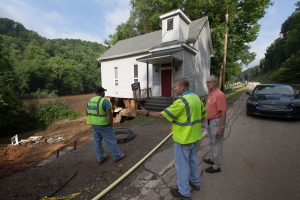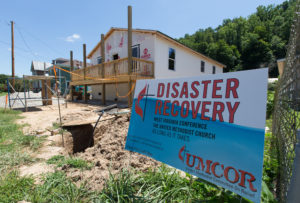It was clergy move day, Thursday, June 23, 2016. What seemed like a strong, all day rain storm was described by the National Weather Service as three quickly successive massive storms that stalled over central and southern West Virginia pelting 44 of West Virginia’s counties.
Busy with dodging the storms to move into the home we built for retirement on the Elk River just north of Charleston, I had not observed the news – until the next day.
Early Friday morning I could see the Elk angrily rushing at the back of our driveway which had not been seen before even in high water. Neighbors were beginning to drag items from their basements. I knew immediately what this meant further up the Elk but could not imagine the breadth of the storms – until I saw the news.
Waters had risen quickly. The normally small and quiet streams now raged with sufficient strength to move buildings off their foundations. As distressing water sought its escape, flooding backed up into areas that have never flooded. In many places, where rainfall typically would find its way down the mountains and hills, the strength and volume of water formed new courses that violently damaged or destroyed anything in their paths including roads and bridges.
Twelve counties were included in the federally declared disaster zone.
Thousands of homes were severely damaged or destroyed. Numerous businesses and schools were also damaged or destroyed. Wells and septic systems were polluted or destroyed, and one regional sanitary water treatment system was compromised. Many private bridges crossing streams to connect homes to roads were washed away.

The Rev. J.F. Lacaria (right) visits with highway contractors Andy Gillenwater (left) and Chris Apperson at Brawley Chapel United Methodist Church near Clendenin, W. Va. The church’s parking lot and much of its foundation were swept away by floodwaters from the Elk River. Photo by Mike DuBose, UMNS
Complicating the disaster is the demographic descriptor of a region that is home to distressed and isolated mountain communities and regional poverty, exacerbating the already limited ability to respond with existing community resources. 23 people were reported dead, including a teenager who was missing for 3 weeks until her body was found in debris in the next town away from her home. Sixteen United Methodist churches were damaged – twelve heavily and one destroyed. Three parsonages were impacted – one heavily.
FEMA confirmed the magnitude of this disaster by saying it is “harder and more severe” than most national disasters because of the geographical breadth of the storms and flood as well as the number of previously distressed communities and regional poverty across the flooded counties.
Immediately, Bishop Sandra Steiner Ball released her assistant to devote his time fully to assess the flood and to develop a plan of response. Relief supplies were distributed with the help of the relief supply network and New Vision Depot, the conference’s warehouse and disaster response center. The West Virginia Conference of The United Methodist Church (WVUMC) was on the ground immediately as was the United Methodist Committee on Relief (UMCOR).
With advice from UMCOR and FEMA, the Bishop recognized the need for full time direction to disaster response and asked me to take on this task. It would be unrealistic to expect our conference disaster coordinators to pastor their churches, manage the depot, provide qualified spiritual care training, conduct certified disaster emergency response training, maintain preparedness for other disasters AND manage conference recovery activity for the June 2016 storms and flood disaster.
Churches opened their doors for partnering organizations to stage supplies as well as to serve as relief stations and emergency shelters. Numerous ecumenical early response teams helped greatly in initial disaster response activities including clean-up, muck-out, feeding stations, and other emergency relief. Several clergy provided pastoral and spiritual care.
We partnered with Volunteer Organizations Active in Disaster (VOAD) where our United Methodist presence and our connection to UMCOR were appreciated, and VOAD placed great trust and responsibility on our shoulders.
We transitioned seamlessly through immediate and intermediate response toward long term recovery. By August 2016, our recovery plan and director were in place. By September, our case managers and construction coordinators were employed.

The disaster recovery ministry of the West Virginia Conference of The United Methodist Church hosts volunteer teams from across the country to help survivors of the June 2016 flood restore their homes and lives. Photo by Mike DuBose, UMNS.
Since then, we have helped over 300 families toward recovery with disaster case management, volunteer work teams, and funding in tandem with partner organizations.
Disaster survivors are classified as tiers one through four. Tier one folks have minimal damage. With personal resources and minimal help, they are able to recover quickly. Tier four survivors have complex recovery situations that include total loss of the home, extreme poverty, and extending issues such as elderly folk, children, or multiple disabilities in the family. Tier two and three have recovery situations in-between those described in tier one and four. Most of the families in our case management are tiers three and four.
The WVUMC have crossed the $3.3 million threshold of direct disaster recovery funds from donations along with two UMCOR grants. The WVUMC sits at a Statewide Unmet Needs Table as one of few remaining funding partners.
A number of survivors have been put on hold by RISE WV, an arm of state government funded by the federal Department of Housing and Urban Development (HUD). As RISE becomes active, we anticipate a number of new cases coming our way for people who do not meet the HUD guidelines. We anticipate needing additional funding to address expenses for recovery plans that come our way.
The WVUMC was recognized by UMCOR for the alert and prompt action of our bishop as well as the speed with which we organized disaster response and recovery. Many of the early response folks have been gone for over a year now.
Two years later as usual and expected, the WVUMC and UMCOR are committed for the long haul.
John W. (Jack) Lipphardt, one of the New Vision with Hope Disaster Response Coordinators. He may be reached via email at: jwlipphardt@aol.com.